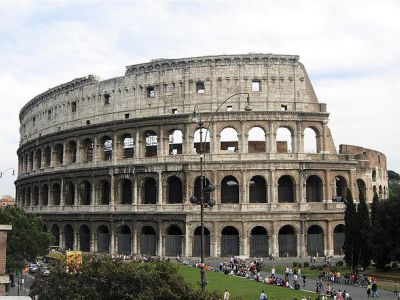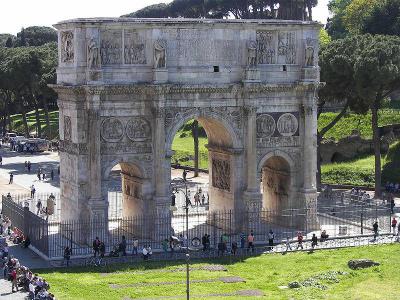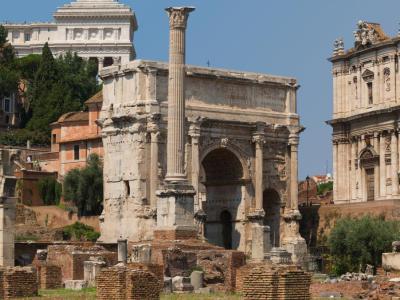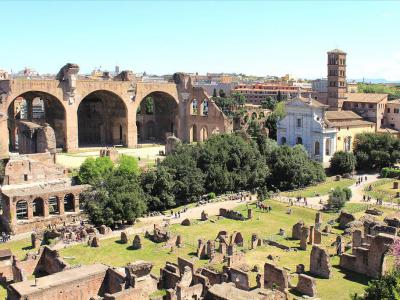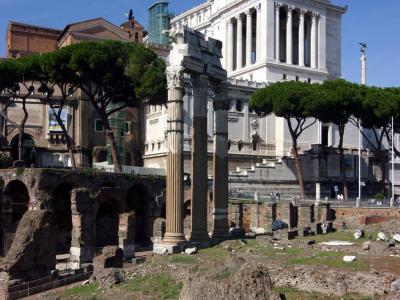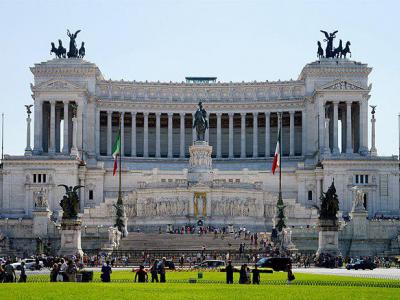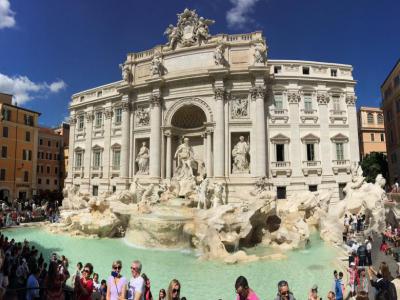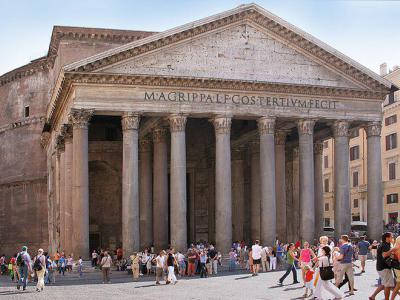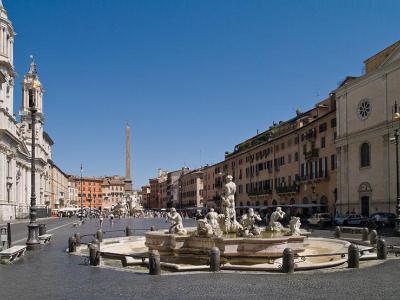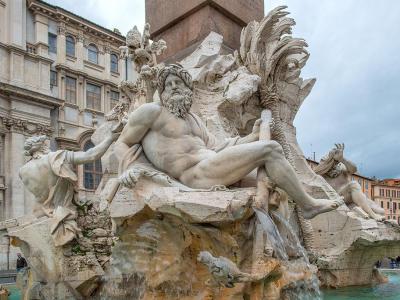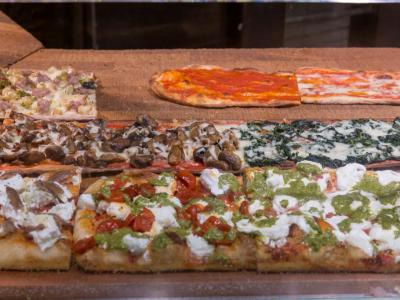Custom Walk in Rome, Italy by ghanula73932 created on 2025-04-23
Guide Location: Italy » Rome
Guide Type: Custom Walk
# of Sights: 11
Tour Duration: 2 Hour(s)
Travel Distance: 4.2 Km or 2.6 Miles
Share Key: AWHHR
Guide Type: Custom Walk
# of Sights: 11
Tour Duration: 2 Hour(s)
Travel Distance: 4.2 Km or 2.6 Miles
Share Key: AWHHR
How It Works
Please retrieve this walk in the GPSmyCity app. Once done, the app will guide you from one tour stop to the next as if you had a personal tour guide. If you created the walk on this website or come to the page via a link, please follow the instructions below to retrieve the walk in the app.
Retrieve This Walk in App
Step 1. Download the app "GPSmyCity: Walks in 1K+ Cities" on Apple App Store or Google Play Store.
Step 2. In the GPSmyCity app, download(or launch) the guide "Rome Map and Walking Tours".
Step 3. Tap the menu button located at upper right corner of the "Walks" screen and select "Retrieve custom walk". Enter the share key: AWHHR
1) Colosseo (Colosseum) (must see)
The Colosseum, Rome’s iconic elliptical amphitheater, is the largest ancient amphitheater ever built, covering 24,000 square meters. Constructed between 69 and 80 AD by the Flavian dynasty, it was initially called the Flavian Amphitheater. Its modern name stems from the Colossus of Nero statue that once stood nearby, with the term "Colosseum" emerging during the medieval period.
Built on the land reclaimed from Emperor Nero’s landscaped Domus Aurea complex after the Great Fire of 64 AD, the Colosseum represented a gift to the Roman people under Emperor Vespasian. It was constructed using travertine, tuff, and concrete and was funded by spoils from the Jewish War. The latter, fought in 70 AD, led to the Siege of Jerusalem and brought back numerous prisoners who largely contributed to the massive workforce needed for the construction. The amphitheater comprised four tiers that could hold between 50,000 and 80,000 spectators at a time. Its free-standing structure features three architectural orders – Doric, Ionic, and Corinthian.
The lowest tier was for the emperor and the royal family, the two middle ones were for the noble Romans and members of government, while the highest tier was for the ordinary citizens. The elaborate system included 80 entrances, passageways for crowd control, and numbered pottery tickets for seating. Admission was free and the main sponsor was the emperor himself.
The Colosseum hosted gladiatorial contests, animal hunts, and mythological reenactments. Events often featured exotic animals imported from Africa and the Middle East. Emperor Trajan's games, for example, involved over 11,000 animals and 10,000 gladiators over 123 days! The below-ground passages were used to bring men and animals into the arena, which was separated from the audience by a ditch. Occasionally, it was reportedly even flooded for naval battles. Executions were common during intervals, with the condemned facing wild beasts or acting out tragic myths.
During the medieval period, the Colosseum served as a fortress and even a stone quarry. Passers-by habitually chipped off pieces of it for souvenirs which, together with some natural causes like earthquakes, led to its partial destruction.
Despite popular belief that the early Christians were martyred here in numbers, evidence suggests that most executions occurred elsewhere. By the 17th century, the Colosseum became recognized as a sacred site. Today, it hosts the Pope’s Good Friday “Way of the Cross” procession.
Only the north side of the building, as well as the underground passages, have survived intact. The arena floor is totally gone. Inside the Colosseum, there's a historical exhibition with both permanent and changing displays.
Tips:
Visit early in the morning or late in the evening to avoid long queues and heat. The ground and first floors are open to visitors without a special ticket, while the subterranean part and the third floor are accessed on pre-booked tours only. Opt for a guided tour to skip lines and access the Forum area. Alternatively, buy tickets in advance or at the Roman Forum. Enhance your experience with an audio guide for detailed historical insights.
Built on the land reclaimed from Emperor Nero’s landscaped Domus Aurea complex after the Great Fire of 64 AD, the Colosseum represented a gift to the Roman people under Emperor Vespasian. It was constructed using travertine, tuff, and concrete and was funded by spoils from the Jewish War. The latter, fought in 70 AD, led to the Siege of Jerusalem and brought back numerous prisoners who largely contributed to the massive workforce needed for the construction. The amphitheater comprised four tiers that could hold between 50,000 and 80,000 spectators at a time. Its free-standing structure features three architectural orders – Doric, Ionic, and Corinthian.
The lowest tier was for the emperor and the royal family, the two middle ones were for the noble Romans and members of government, while the highest tier was for the ordinary citizens. The elaborate system included 80 entrances, passageways for crowd control, and numbered pottery tickets for seating. Admission was free and the main sponsor was the emperor himself.
The Colosseum hosted gladiatorial contests, animal hunts, and mythological reenactments. Events often featured exotic animals imported from Africa and the Middle East. Emperor Trajan's games, for example, involved over 11,000 animals and 10,000 gladiators over 123 days! The below-ground passages were used to bring men and animals into the arena, which was separated from the audience by a ditch. Occasionally, it was reportedly even flooded for naval battles. Executions were common during intervals, with the condemned facing wild beasts or acting out tragic myths.
During the medieval period, the Colosseum served as a fortress and even a stone quarry. Passers-by habitually chipped off pieces of it for souvenirs which, together with some natural causes like earthquakes, led to its partial destruction.
Despite popular belief that the early Christians were martyred here in numbers, evidence suggests that most executions occurred elsewhere. By the 17th century, the Colosseum became recognized as a sacred site. Today, it hosts the Pope’s Good Friday “Way of the Cross” procession.
Only the north side of the building, as well as the underground passages, have survived intact. The arena floor is totally gone. Inside the Colosseum, there's a historical exhibition with both permanent and changing displays.
Tips:
Visit early in the morning or late in the evening to avoid long queues and heat. The ground and first floors are open to visitors without a special ticket, while the subterranean part and the third floor are accessed on pre-booked tours only. Opt for a guided tour to skip lines and access the Forum area. Alternatively, buy tickets in advance or at the Roman Forum. Enhance your experience with an audio guide for detailed historical insights.
2) Arco di Costantino (Arch of Constantine)
On October 28, 312 AD, Roman emperor Constantine had an epic battle with his rival, co-emperor Maxentius. It went down in history as the Battle of the Milvian Bridge. Victorious Constantine became the sole ruler of the Roman Empire, thus ending the system of Tetrarchy. He is generally regarded as the last great emperor of Rome.
The Arch of Constantine, Rome’s largest triumphal arch, was dedicated in 315 AD to commemorate Constantine’s victory. Located between the Colosseum and Palatine Hill, it spans the Road of Triumph, marking the route of Roman military parades. The arch stands 21 meters high, featuring three bays and incorporating elements from earlier monuments, including reliefs and statues from the reigns of Trajan, Hadrian, and Marcus Aurelius, reworked to celebrate Constantine.
Scholars have debated the arch's origins, suggesting it may predate Constantine and even have ties to Hadrian’s or Maxentius’s reigns. The arch exemplifies Late Antique artistic styles, with a blend of reused classical Greek-inspired elements and newly-created simpler, symbolic works. Reliefs from earlier monuments display classical proportions and dynamic movement, while the 4th-century additions feature rigid and geometric forms, reflecting changes in artistic priorities or economic constraints at that time. This stylistic contrast highlights the transition from Rome’s classical tradition to the evolving aesthetics of Late Antiquity.
Decorative elements on the arch include reliefs of Dacians from Trajan’s reign, panels depicting Marcus Aurelius’s military campaigns, and roundels from Hadrian’s era reworked to depict Constantine. A Constantinian frieze narrates his campaign against Maxentius, while inscriptions celebrate him as a pious and victorious leader.
One such inscription credits Constantine with saving the Roman people by divine inspiration. It refers to his vision before the Battle of Milvian Bridge in 312 AD, where he claimed to have seen a cross in the sky and heard the words: "In this sign, you will conquer." This event is often linked to Constantine's promotion of Christianity within the Roman Empire. The arch also balances pagan and Christian themes, symbolizing Constantine’s shifting religious stance during this period.
The Arch of Constantine's global influence as a monument includes the likes of the Arch of Triumph in Paris, the Marble Arch in London, Washington Union Station in Washington DC, and the American Museum of Natural History in New York City.
The Arch of Constantine, Rome’s largest triumphal arch, was dedicated in 315 AD to commemorate Constantine’s victory. Located between the Colosseum and Palatine Hill, it spans the Road of Triumph, marking the route of Roman military parades. The arch stands 21 meters high, featuring three bays and incorporating elements from earlier monuments, including reliefs and statues from the reigns of Trajan, Hadrian, and Marcus Aurelius, reworked to celebrate Constantine.
Scholars have debated the arch's origins, suggesting it may predate Constantine and even have ties to Hadrian’s or Maxentius’s reigns. The arch exemplifies Late Antique artistic styles, with a blend of reused classical Greek-inspired elements and newly-created simpler, symbolic works. Reliefs from earlier monuments display classical proportions and dynamic movement, while the 4th-century additions feature rigid and geometric forms, reflecting changes in artistic priorities or economic constraints at that time. This stylistic contrast highlights the transition from Rome’s classical tradition to the evolving aesthetics of Late Antiquity.
Decorative elements on the arch include reliefs of Dacians from Trajan’s reign, panels depicting Marcus Aurelius’s military campaigns, and roundels from Hadrian’s era reworked to depict Constantine. A Constantinian frieze narrates his campaign against Maxentius, while inscriptions celebrate him as a pious and victorious leader.
One such inscription credits Constantine with saving the Roman people by divine inspiration. It refers to his vision before the Battle of Milvian Bridge in 312 AD, where he claimed to have seen a cross in the sky and heard the words: "In this sign, you will conquer." This event is often linked to Constantine's promotion of Christianity within the Roman Empire. The arch also balances pagan and Christian themes, symbolizing Constantine’s shifting religious stance during this period.
The Arch of Constantine's global influence as a monument includes the likes of the Arch of Triumph in Paris, the Marble Arch in London, Washington Union Station in Washington DC, and the American Museum of Natural History in New York City.
3) Arco di Settimio Severo (Arch of Septimius Severus)
The Arch of Septimius Severus is one of Rome’s most impressive triumphal arches. Built in 203 AD, it was dedicated to commemorate Emperor Septimius Severus and his sons, Caracalla and Geta, for their victories against the Parthians (which is modern-day Iran) in campaigns during the 190s AD.
This grand white marble structure was erected during the twilight of the Roman Empire’s golden age, when its eventual decline had begun. Yet the Romans of the era still believed in the eternity of their city.
Severus's victory over the Parthians was particularly significant, as it avenged Rome’s humiliating defeat some 300 years earlier. Captured and executed in a gruesome display of his greed, leader of that campaign, general Marcus Crassus, reportedly had molten gold poured down his throat-an infamous moment in Roman history.
The arch itself is a masterpiece of Roman engineering and artistry. It is elevated on a travertine base and originally had steps leading up from the Forum’s ground level. Its central archway features a stunning coffered semicircular vault, while lateral openings provide additional passageways. The structure is adorned with composite columns on pedestals, and its spandrels bear relief carvings of Winged Victories. Inside the south pier, a staircase allows access to the top, where a once-magnificent statue of Severus and his sons in a four-horse chariot (quadriga) stood, accompanied by soldiers.
Despite the arch’s dedication to both Caracalla and Geta, political turmoil soon altered its legacy. Following Severus's death, the two brothers ruled jointly, but their relationship was tense. In 212 AD, Caracalla assassinated Geta and enacted the so-called “damnation of memory”, a Roman practice of erasing a person's existence from history. All inscriptions and images of Geta were subsequently removed from monuments, including the Arch of Septimius Severus, leaving visible gaps where his name was once carved.
The architect of the arch remains unknown, but the structure’s refined craftsmanship speaks for itself.
Interestingly, the arch also made an appearance in cinema history. In the “Roman Holiday” movie, the memorable first meeting between Princess Ann (played by Audrey Hepburn) and Joe Bradley (played by Gregory Peck) takes place near the Arch of Septimius Severus. Ann, escaping the palace and under the influence of a sleeping pill, rests by the arch and the Temple of Saturn. Joe, leaving a poker game, finds her there and, unable to learn her address, takes her to his apartment by taxi.
Today, car traffic is prohibited in this area. And while you may well fall asleep there on the parapet and hope that Gregory Peck will pick you up, dreaming that he will catch a taxi and take you to his place on Via Margutta is a complete utopia.
This grand white marble structure was erected during the twilight of the Roman Empire’s golden age, when its eventual decline had begun. Yet the Romans of the era still believed in the eternity of their city.
Severus's victory over the Parthians was particularly significant, as it avenged Rome’s humiliating defeat some 300 years earlier. Captured and executed in a gruesome display of his greed, leader of that campaign, general Marcus Crassus, reportedly had molten gold poured down his throat-an infamous moment in Roman history.
The arch itself is a masterpiece of Roman engineering and artistry. It is elevated on a travertine base and originally had steps leading up from the Forum’s ground level. Its central archway features a stunning coffered semicircular vault, while lateral openings provide additional passageways. The structure is adorned with composite columns on pedestals, and its spandrels bear relief carvings of Winged Victories. Inside the south pier, a staircase allows access to the top, where a once-magnificent statue of Severus and his sons in a four-horse chariot (quadriga) stood, accompanied by soldiers.
Despite the arch’s dedication to both Caracalla and Geta, political turmoil soon altered its legacy. Following Severus's death, the two brothers ruled jointly, but their relationship was tense. In 212 AD, Caracalla assassinated Geta and enacted the so-called “damnation of memory”, a Roman practice of erasing a person's existence from history. All inscriptions and images of Geta were subsequently removed from monuments, including the Arch of Septimius Severus, leaving visible gaps where his name was once carved.
The architect of the arch remains unknown, but the structure’s refined craftsmanship speaks for itself.
Interestingly, the arch also made an appearance in cinema history. In the “Roman Holiday” movie, the memorable first meeting between Princess Ann (played by Audrey Hepburn) and Joe Bradley (played by Gregory Peck) takes place near the Arch of Septimius Severus. Ann, escaping the palace and under the influence of a sleeping pill, rests by the arch and the Temple of Saturn. Joe, leaving a poker game, finds her there and, unable to learn her address, takes her to his apartment by taxi.
Today, car traffic is prohibited in this area. And while you may well fall asleep there on the parapet and hope that Gregory Peck will pick you up, dreaming that he will catch a taxi and take you to his place on Via Margutta is a complete utopia.
4) Foro Romano (Roman Forum) (must see)
The Roman Forum, once the pulsating heart of ancient Rome's public life, evolved from a simple marketplace around 500 BC into the epicenter of Roman political, social, and religious activity. Known as the Forum Magnum, it became a hub for triumphal processions, public speeches, elections, criminal trials, gladiatorial matches, and commerce. Statues and monuments celebrating Roman leaders solidified its status as one of history’s most significant meeting places.
Initially featuring early structures like the Regia (a royal residence) and the Temple of Vesta, the Forum developed into a formal assembly area called the Comitium, where the Senate and government convened. Over centuries, temples, tribunals, and public buildings, such as the Senate House and the Temple of Saturn, transformed the Forum into a multifunctional hub. The Basilica Aemilia, built in 179 BC, expanded judicial activities, while Julius Caesar’s enhancements, including the Basilica Julia and Curia Julia, underscored its role as a center for politics, commerce, and religion.
Despite its prominence, the Forum’s importance began to decline with the emergence of grander structures, such as Trajan's Forum and the Basilica Ulpia, to the north. Unlike the more planned Imperial Forums, the Roman Forum grew organically, reflecting a mix of architectural styles across periods. Constantine the Great’s construction of the Maxentius Basilica in 312 AD marked its final significant addition, temporarily restoring its political centrality. However, the fall of the Western Roman Empire in the 5th century AD led to the Forum's destruction and decline.
Today, the Roman Forum is a sprawling ruin but remains a priceless historical treasure. Though reduced to crumbling remains, it continues to captivate visitors, drawing nearly five million annually. Highlights of the site include the Sacred Street, the Arch of Titus, and remnants of iconic buildings like the Temple of Castor and Pollux.
Initially featuring early structures like the Regia (a royal residence) and the Temple of Vesta, the Forum developed into a formal assembly area called the Comitium, where the Senate and government convened. Over centuries, temples, tribunals, and public buildings, such as the Senate House and the Temple of Saturn, transformed the Forum into a multifunctional hub. The Basilica Aemilia, built in 179 BC, expanded judicial activities, while Julius Caesar’s enhancements, including the Basilica Julia and Curia Julia, underscored its role as a center for politics, commerce, and religion.
Despite its prominence, the Forum’s importance began to decline with the emergence of grander structures, such as Trajan's Forum and the Basilica Ulpia, to the north. Unlike the more planned Imperial Forums, the Roman Forum grew organically, reflecting a mix of architectural styles across periods. Constantine the Great’s construction of the Maxentius Basilica in 312 AD marked its final significant addition, temporarily restoring its political centrality. However, the fall of the Western Roman Empire in the 5th century AD led to the Forum's destruction and decline.
Today, the Roman Forum is a sprawling ruin but remains a priceless historical treasure. Though reduced to crumbling remains, it continues to captivate visitors, drawing nearly five million annually. Highlights of the site include the Sacred Street, the Arch of Titus, and remnants of iconic buildings like the Temple of Castor and Pollux.
5) Foro di Cesare (Forum of Caesar)
Julius Caesar is arguably the best known and most dominant personality in Roman history. He became the dictator of Rome at the end of the Roman Republic period. Known for his military genius, he expanded Rome's territory through successful campaigns, particularly in Gaul, which is modern-day France, Belgium, the Netherlands, and parts of Germany. His assassination in 44 BC by a group of senators led to the demise of the Roman Republic and the rise of the Roman Empire.
Julius Caesar built the Forum of Caesar to showcase his power and accomplishments. The forum served both as a symbol of his political and military successes, particularly his conquest of Gaul, and as a practical solution to overcrowding in the Roman Forum. It also allowed Caesar to enhance his image, connecting his name to a grand architectural project and solidifying his legacy in the city.
A central element of the forum was the Temple of Venus Genetrix, which Caesar vowed to build before the Battle of Pharsalus in 48 BC. By doing so, he sought the favor of Venus, the legendary ancestor of his gens Julia, in a battle against rival Pompey, who also worshiped the goddess. The temple was completed after Caesar's assassination.
The Forum of Caesar functioned as more than just an expansion of the Roman Forum. It became a hub for public and senatorial affairs, reinforcing Caesar's close association with the Senate. He even had the Senate meet in front of the temple, a move that was unpopular among senators. The Julian Senate House was also reconstructed under Caesar, bringing the senate house closer to his forum and further symbolizing his political dominance.
The forum housed significant statues, including an equestrian statue of Caesar, a statue of his favorite horse, and later a gilded statue of Cleopatra, thus setting a precedent for honoring notable women. Inside the Temple of Venus Genetrix, a collection of art and artifacts and a prized collection of engraved gems were displayed.
Today, the Forum of Caesar is largely in ruins, but several notable remains can still be seen. The most visible of them are the Temple of Venus Genetrix's ruins. While much of the forum is beneath the level of modern streets lined with contemporary buildings, part of the old paved area, showcasing the layout of the ancient public space, is still in sight. Coupled with some imagination, it can allow you to fully envision the original space.
Julius Caesar built the Forum of Caesar to showcase his power and accomplishments. The forum served both as a symbol of his political and military successes, particularly his conquest of Gaul, and as a practical solution to overcrowding in the Roman Forum. It also allowed Caesar to enhance his image, connecting his name to a grand architectural project and solidifying his legacy in the city.
A central element of the forum was the Temple of Venus Genetrix, which Caesar vowed to build before the Battle of Pharsalus in 48 BC. By doing so, he sought the favor of Venus, the legendary ancestor of his gens Julia, in a battle against rival Pompey, who also worshiped the goddess. The temple was completed after Caesar's assassination.
The Forum of Caesar functioned as more than just an expansion of the Roman Forum. It became a hub for public and senatorial affairs, reinforcing Caesar's close association with the Senate. He even had the Senate meet in front of the temple, a move that was unpopular among senators. The Julian Senate House was also reconstructed under Caesar, bringing the senate house closer to his forum and further symbolizing his political dominance.
The forum housed significant statues, including an equestrian statue of Caesar, a statue of his favorite horse, and later a gilded statue of Cleopatra, thus setting a precedent for honoring notable women. Inside the Temple of Venus Genetrix, a collection of art and artifacts and a prized collection of engraved gems were displayed.
Today, the Forum of Caesar is largely in ruins, but several notable remains can still be seen. The most visible of them are the Temple of Venus Genetrix's ruins. While much of the forum is beneath the level of modern streets lined with contemporary buildings, part of the old paved area, showcasing the layout of the ancient public space, is still in sight. Coupled with some imagination, it can allow you to fully envision the original space.
6) Vittoriano (Victor Emmanuel II National Monument) (must see)
The Victor Emmanuel II National Monument, also known as the Altar of the Fatherland, honors Italy’s first king and symbolizes the nation’s unification. Constructed from 1885 to 1935, its design was inspired by the Roman Forum. The neoclassical monument blends Hellenistic influences with modern urban design, featuring grand staircases, Corinthian columns, fountains, and statues, including a striking equestrian statue of Victor Emmanuel II.
Its dimensions are imposing, with a width of 135 meters and a height of 81 meters, including statues of the goddess Victoria atop quadrigas. Also adding to its grandeur are the two colossal Italian tricolors at the sides.
The monument's key features include the Tomb of the Unknown Soldier, inaugurated in 1921. Its eternal flames perpetually guarded by soldiers reflect classical traditions of remembrance. Sculptures like The Thought and The Action are complemented by allegorical decorations and mosaics highlighting Italian virtues, sciences, and intellectual achievements. The site also honors Italy's pre-unification legacy through sculptures of 14 historic capitals and other artistic elements.
Ascending the central staircase rewards visitors with a view of the monument itself but also a panoramic vista over the city. This elevated spot offers an ideal opportunity for capturing memorable photos. For added convenience, a lift was installed in 2007, enabling visitors to reach the rooftop and enjoy a bird's-eye panorama of Rome (please note that there is a small fee for the ride).
Flanking Venice Square, the Fountains of the Two Seas symbolize Italy's geographical unity, representing the Adriatic and Tyrrhenian Seas. Beneath the monument lies a crypt built with materials from World War I battlefields, creating a sacred space for reflection.
At the base of the complex, visitors can explore the Central Museum of Italian Unification, which chronicles the country’s history from the late 18th century to World War I, and the Shrine of the Flags, showcasing military flags and artifacts. The admission is free.
The monument is a centerpiece for national celebrations like Republic Day and Liberation Day. Although initially met with controversy and subjected to derogatory nicknames like the "wedding cake," it has become one of the city's most popular attractions after the Vatican and the Roman Ruins. Despite some locals considering it tacky, there is an undeniable allure in witnessing triumphal architecture that aspires to rival the grandeur of ancient structures.
Tip:
Visit the monument at night when it is beautifully illuminated.
Its dimensions are imposing, with a width of 135 meters and a height of 81 meters, including statues of the goddess Victoria atop quadrigas. Also adding to its grandeur are the two colossal Italian tricolors at the sides.
The monument's key features include the Tomb of the Unknown Soldier, inaugurated in 1921. Its eternal flames perpetually guarded by soldiers reflect classical traditions of remembrance. Sculptures like The Thought and The Action are complemented by allegorical decorations and mosaics highlighting Italian virtues, sciences, and intellectual achievements. The site also honors Italy's pre-unification legacy through sculptures of 14 historic capitals and other artistic elements.
Ascending the central staircase rewards visitors with a view of the monument itself but also a panoramic vista over the city. This elevated spot offers an ideal opportunity for capturing memorable photos. For added convenience, a lift was installed in 2007, enabling visitors to reach the rooftop and enjoy a bird's-eye panorama of Rome (please note that there is a small fee for the ride).
Flanking Venice Square, the Fountains of the Two Seas symbolize Italy's geographical unity, representing the Adriatic and Tyrrhenian Seas. Beneath the monument lies a crypt built with materials from World War I battlefields, creating a sacred space for reflection.
At the base of the complex, visitors can explore the Central Museum of Italian Unification, which chronicles the country’s history from the late 18th century to World War I, and the Shrine of the Flags, showcasing military flags and artifacts. The admission is free.
The monument is a centerpiece for national celebrations like Republic Day and Liberation Day. Although initially met with controversy and subjected to derogatory nicknames like the "wedding cake," it has become one of the city's most popular attractions after the Vatican and the Roman Ruins. Despite some locals considering it tacky, there is an undeniable allure in witnessing triumphal architecture that aspires to rival the grandeur of ancient structures.
Tip:
Visit the monument at night when it is beautifully illuminated.
7) Piazza di Trevi & Fontana di Trevi (Trevi Square & Trevi Fountain) (must see)
The Trevi Fountain is one of Rome’s most iconic landmarks, drawing visitors to the eponymous Trevi Square all day long. Surprisingly, the fountain was not initially built in the heart of the city; instead, the city grew around it. Its name derives from the Latin word "trivium," which means “three streets,” as it sits at the junction of three streets: De Crocicchi, Poli, and Delle Muratte.
The fountain’s history dates back to 1629 when Pope Urban VIII commissioned Gian Lorenzo Bernini to redesign it, though his plans were never realized. Later, Pope Clement XII organized a competition in 1730, leading to Nicola Salvi's selection for the project, who incorporated the fountain into the rear of the Poli Palace. Salvi passed away before its completion. Giuseppe Pannini and other artists finalized the work in 1762.
Measuring over 26 meters in height and 49 meters in width, it is the largest Baroque fountain in Rome.
The Trevi Fountain features a Corinthian façade and bas-reliefs depicting the origins of the Acqua Vergine aqueduct, constructed in 19 BC. According to legend, a virgin guided Roman engineers to the aqueduct’s source, an event depicted in the fountain’s bas-reliefs. The aqueduct, which survived the Gothic invasions and was restored during the Middle Ages, still supplies water to the fountain today.
At the heart of the fountain is Oceanus, depicted riding a shell-shaped chariot drawn by two horses and guided by Tritons. The horses symbolize the sea’s contrasting moods-calm and turbulent. Flanking Oceanus are the statues of Abundance and Salubrity, representing prosperity and health. The symmetrical Rococo design combines dynamic artistry with Baroque grandeur, reflecting 18th-century European trends.
The Trevi Fountain is also known for the tradition of tossing coins, which promises a return to Rome. Popularized by the 1954 Hollywood film "Three Coins in the Fountain," visitors toss coins over their left shoulder with their right hand, generating daily about €3,000. This money, collected by municipal authorities, is donated to charity.
Celebrated in films like Roman Holiday and La Dolce Vita, the Trevi Fountain’s global fame is further evidenced by replicas worldwide. Access to the fountain is now limited to 400 visitors at a time, ensuring a more enjoyable visit to this timeless masterpiece. Surrounding the fountain are charming shops, restaurants, and gelaterias, making it a delightful spot to soak in Rome’s vibrant atmosphere.
Tip:
The fountain holds particular allure at night, especially after 10 pm when it is beautifully illuminated and the crowds dissipate, allowing you to enjoy the site almost exclusively.
The fountain’s history dates back to 1629 when Pope Urban VIII commissioned Gian Lorenzo Bernini to redesign it, though his plans were never realized. Later, Pope Clement XII organized a competition in 1730, leading to Nicola Salvi's selection for the project, who incorporated the fountain into the rear of the Poli Palace. Salvi passed away before its completion. Giuseppe Pannini and other artists finalized the work in 1762.
Measuring over 26 meters in height and 49 meters in width, it is the largest Baroque fountain in Rome.
The Trevi Fountain features a Corinthian façade and bas-reliefs depicting the origins of the Acqua Vergine aqueduct, constructed in 19 BC. According to legend, a virgin guided Roman engineers to the aqueduct’s source, an event depicted in the fountain’s bas-reliefs. The aqueduct, which survived the Gothic invasions and was restored during the Middle Ages, still supplies water to the fountain today.
At the heart of the fountain is Oceanus, depicted riding a shell-shaped chariot drawn by two horses and guided by Tritons. The horses symbolize the sea’s contrasting moods-calm and turbulent. Flanking Oceanus are the statues of Abundance and Salubrity, representing prosperity and health. The symmetrical Rococo design combines dynamic artistry with Baroque grandeur, reflecting 18th-century European trends.
The Trevi Fountain is also known for the tradition of tossing coins, which promises a return to Rome. Popularized by the 1954 Hollywood film "Three Coins in the Fountain," visitors toss coins over their left shoulder with their right hand, generating daily about €3,000. This money, collected by municipal authorities, is donated to charity.
Celebrated in films like Roman Holiday and La Dolce Vita, the Trevi Fountain’s global fame is further evidenced by replicas worldwide. Access to the fountain is now limited to 400 visitors at a time, ensuring a more enjoyable visit to this timeless masterpiece. Surrounding the fountain are charming shops, restaurants, and gelaterias, making it a delightful spot to soak in Rome’s vibrant atmosphere.
Tip:
The fountain holds particular allure at night, especially after 10 pm when it is beautifully illuminated and the crowds dissipate, allowing you to enjoy the site almost exclusively.
8) Pantheon (must see)
The Pantheon is one of Rome’s most iconic landmarks, renowned for its architectural brilliance. Originally a Roman temple, its name comes from the Ancient Greek "pan theos," which means dedication to all gods. Built on the site of a temple commissioned by consul Marcus Agrippa during Augustus’ reign, the current structure was completed under Emperor Hadrian around 126 AD. It was transformed into a Catholic Church of Saint Mary and the Martyrs in 609 AD, ensuring its preservation through centuries.
The Pantheon’s unique design combines a classical portico supported by Corinthian granite columns with a domed cylindrical structure (called a rotunda). The unsupported concrete dome, still the largest of its kind in the world, features a central oculus that provides natural light, ventilation, and symbolic celestial connections. The rotunda's harmonious dimensions-43 meters in both height and diameter-epitomize Roman engineering excellence, while its original massive bronze doors, each weighing over 20 tons, and intricate drainage system (allowing to effectively divert rainwater) highlight the ingenuity of its creators.
Throughout its history, the Pantheon has been a vibrant part of Roman life. It served as a burial site during the Renaissance, housing notable figures like painter Raphael and Italian kings Victor Emmanuel II and Umberto I. Its materials, such as bronze, have been repurposed for other projects like Bernini’s baldachin above the high altar of Saint Peter's Basilica. However, its core structure remains remarkably intact. Today, the church still host religious ceremonies, including masses, weddings, and Pentecost celebrations.
The Pantheon’s influence extends far beyond Rome. Its dome inspired architectural marvels like the Florence Cathedral and Rotunda of the U.S. Capital in Washington D.C., while its combination of classical and modern elements shaped countless government and academic buildings worldwide.
With over six million annual visitors, the Pantheon remains a symbol of Roman ingenuity and artistic achievement. Tourists can enjoy free entry to this historic site or soak in its splendor from Rotonda Square, savoring gelato while marveling at its timeless beauty.
Tip:
Incredible at night (from the outside), it is especially so if you enjoy musicians with talent and engagement... but beware of pickpockets.
The Pantheon’s unique design combines a classical portico supported by Corinthian granite columns with a domed cylindrical structure (called a rotunda). The unsupported concrete dome, still the largest of its kind in the world, features a central oculus that provides natural light, ventilation, and symbolic celestial connections. The rotunda's harmonious dimensions-43 meters in both height and diameter-epitomize Roman engineering excellence, while its original massive bronze doors, each weighing over 20 tons, and intricate drainage system (allowing to effectively divert rainwater) highlight the ingenuity of its creators.
Throughout its history, the Pantheon has been a vibrant part of Roman life. It served as a burial site during the Renaissance, housing notable figures like painter Raphael and Italian kings Victor Emmanuel II and Umberto I. Its materials, such as bronze, have been repurposed for other projects like Bernini’s baldachin above the high altar of Saint Peter's Basilica. However, its core structure remains remarkably intact. Today, the church still host religious ceremonies, including masses, weddings, and Pentecost celebrations.
The Pantheon’s influence extends far beyond Rome. Its dome inspired architectural marvels like the Florence Cathedral and Rotunda of the U.S. Capital in Washington D.C., while its combination of classical and modern elements shaped countless government and academic buildings worldwide.
With over six million annual visitors, the Pantheon remains a symbol of Roman ingenuity and artistic achievement. Tourists can enjoy free entry to this historic site or soak in its splendor from Rotonda Square, savoring gelato while marveling at its timeless beauty.
Tip:
Incredible at night (from the outside), it is especially so if you enjoy musicians with talent and engagement... but beware of pickpockets.
9) Piazza Navona (Navona Square) (must see)
Navona Square, one of Rome’s most iconic places, is built on the site of the ancient (1st-century AD) Stadium of Domitian. The stadium’s elongated oval shape defines the square’s layout, which was originally designed for Roman games (or agones). Over time, the name evolved from Circus Agonalis (which means “competition arena”) to Navona. After the fall of the Roman Empire, the stadium fell into ruin and was quarried for materials, leaving few remnants today.
In the late 15th century, Navona Square was designated a public space when the city market moved there from Capitoline Hill. It became a celebrated example of Baroque architecture and art during the mid-17th century under Pope Innocent X, whose family property, the Pamphili Palace, overlooks the square. The latter also features several masterpieces, including Gian Lorenzo Bernini’s Fountain of the Four Rivers at its center, crowned by the Obelisk of Domitian. The renowned Church of Saint Agnes in Agone with its impressive dome further highlights the area's artistic significance. Also noteworthy are the Braschi Palace, presently home to the Museum of Rome, and the Cupis Palace, which now offers pre-booked accommodations.
Navona Square is also home to two additional fountains. The Fountain of the Moor, at the southern end, was originally sculpted by Giacomo della Porta in 1575, with Bernini adding a statue of a Moor wrestling a dolphin in 1673. At the northern end, the Fountain of Neptune, also by della Porta (created in 1574), gained its central Neptune statue in 1878.
The square has a rich cultural history, hosting theatrical performances and festivals, including a popular annual Christmas market, from December to January.
Navona Square made an appearance in several movies, including “Angels & Demons” (of 2008, starring Tom Hanks), “Yesterday, Today and Tomorrow” (with Sophie Loren, made in 1964), and “The Talented Mr. Ripley” (directed in 1999 by Anthony Minghella, featuring Matt Damon). The atmosphere in Navona Square exudes a cool and relaxed vibe which, complete with its cinematic and architectural appeal, makes it an ideal spot for photography.
Tip:
In the evenings, when the central fountain is illuminated, the square becomes particularly scenic.
If looking for more intimate and more value-for-money meals and refreshments, consider venturing onto one of the side streets adjacent to the square, filled with multiple eateries and cafes.
In the late 15th century, Navona Square was designated a public space when the city market moved there from Capitoline Hill. It became a celebrated example of Baroque architecture and art during the mid-17th century under Pope Innocent X, whose family property, the Pamphili Palace, overlooks the square. The latter also features several masterpieces, including Gian Lorenzo Bernini’s Fountain of the Four Rivers at its center, crowned by the Obelisk of Domitian. The renowned Church of Saint Agnes in Agone with its impressive dome further highlights the area's artistic significance. Also noteworthy are the Braschi Palace, presently home to the Museum of Rome, and the Cupis Palace, which now offers pre-booked accommodations.
Navona Square is also home to two additional fountains. The Fountain of the Moor, at the southern end, was originally sculpted by Giacomo della Porta in 1575, with Bernini adding a statue of a Moor wrestling a dolphin in 1673. At the northern end, the Fountain of Neptune, also by della Porta (created in 1574), gained its central Neptune statue in 1878.
The square has a rich cultural history, hosting theatrical performances and festivals, including a popular annual Christmas market, from December to January.
Navona Square made an appearance in several movies, including “Angels & Demons” (of 2008, starring Tom Hanks), “Yesterday, Today and Tomorrow” (with Sophie Loren, made in 1964), and “The Talented Mr. Ripley” (directed in 1999 by Anthony Minghella, featuring Matt Damon). The atmosphere in Navona Square exudes a cool and relaxed vibe which, complete with its cinematic and architectural appeal, makes it an ideal spot for photography.
Tip:
In the evenings, when the central fountain is illuminated, the square becomes particularly scenic.
If looking for more intimate and more value-for-money meals and refreshments, consider venturing onto one of the side streets adjacent to the square, filled with multiple eateries and cafes.
10) Fontana dei Quattro Fiumi (Fountain of the Four Rivers) (must see)
The focal point of Navona Square, the Fountain of the Four Rivers has been in place since the 17th century. While Rome has a longstanding affinity for fountains, dating back to antiquity, the Baroque era brought a new dimension to these water features, showcasing the generosity of the papacy.
In the case of the Fountain of the Four Rivers, Pope Innocent X, whose family seat – the Pamphili Palace – overlooks the square, entrusted the task to one of the most groundbreaking artists of the time, Gian Lorenzo Bernini. Created in 1651, the fountain was Rome's pinnacle achievement in fountain design, a symbolic masterpiece brimming with the dynamic and dramatic elements sought after by Baroque artists. Its central Egyptian obelisk is crowned with the Pamphili emblem, a dove with an olive twig.
Pope Innocent X chose Bernini after being secretly shown his model. The fountain was innovative, combining sculpture and architecture in a way unmatched by previous Roman fountains.
Here, the travertine base supports sculptures of four river gods, representing the major rivers of the continents over which papal authority had extended at that time. These include the Nile (for Africa), the Danube (for Europe), the Ganges (for Asia), and the Plate (for the Americas). Each figure conveys symbolic details: the Ganges is depicted holding a long oar, symbolizing the river's navigability; the Nile's veiled head signifies its unknown source; the Danube, the largest river near Rome touches the Pope's coat of arms; and the Plate sits atop a pile of coins, reflecting America’s wealth.
The fountain's unveiling on June 12, 1651, was marked by grand celebrations orchestrated by the Pamphili family. Allegorical figures of Fame and Curiosity paraded the streets, urging Romans to witness the reveal. The crowd marveled at the lifelike sculptures and water features, described as naturalistic and astonishing.
However, the project faced significant public opposition. Critics condemned its expense during the famine of 1646 to 1648, expressing their discontent through pasquinades demanding "Bread, not fountains." Street vendors and Roman Jews lamented their displacement from the square's market, which was closed to enhance its splendor.
Despite the controversy, the Fountain of the Four Rivers remains a cornerstone of Rome’s cultural and architectural legacy, blending mythology, artistry, and geographical narratives.
Tip:
To capture the essence of this fountain in photographs, it is recommended to shoot from various angles and positions, so as to get as much detail as possible. With ample space surrounding the fountain, take your time to find the perfect shot-or perhaps even multiple perfect shots.
In the case of the Fountain of the Four Rivers, Pope Innocent X, whose family seat – the Pamphili Palace – overlooks the square, entrusted the task to one of the most groundbreaking artists of the time, Gian Lorenzo Bernini. Created in 1651, the fountain was Rome's pinnacle achievement in fountain design, a symbolic masterpiece brimming with the dynamic and dramatic elements sought after by Baroque artists. Its central Egyptian obelisk is crowned with the Pamphili emblem, a dove with an olive twig.
Pope Innocent X chose Bernini after being secretly shown his model. The fountain was innovative, combining sculpture and architecture in a way unmatched by previous Roman fountains.
Here, the travertine base supports sculptures of four river gods, representing the major rivers of the continents over which papal authority had extended at that time. These include the Nile (for Africa), the Danube (for Europe), the Ganges (for Asia), and the Plate (for the Americas). Each figure conveys symbolic details: the Ganges is depicted holding a long oar, symbolizing the river's navigability; the Nile's veiled head signifies its unknown source; the Danube, the largest river near Rome touches the Pope's coat of arms; and the Plate sits atop a pile of coins, reflecting America’s wealth.
The fountain's unveiling on June 12, 1651, was marked by grand celebrations orchestrated by the Pamphili family. Allegorical figures of Fame and Curiosity paraded the streets, urging Romans to witness the reveal. The crowd marveled at the lifelike sculptures and water features, described as naturalistic and astonishing.
However, the project faced significant public opposition. Critics condemned its expense during the famine of 1646 to 1648, expressing their discontent through pasquinades demanding "Bread, not fountains." Street vendors and Roman Jews lamented their displacement from the square's market, which was closed to enhance its splendor.
Despite the controversy, the Fountain of the Four Rivers remains a cornerstone of Rome’s cultural and architectural legacy, blending mythology, artistry, and geographical narratives.
Tip:
To capture the essence of this fountain in photographs, it is recommended to shoot from various angles and positions, so as to get as much detail as possible. With ample space surrounding the fountain, take your time to find the perfect shot-or perhaps even multiple perfect shots.
11) Antico Forno Rascioli
As part of the esteemed Roscioli family's culinary empire, this bakery churns out amazing baked goods for 13 hours a day, with the inviting aroma of freshly baked bread permeating Via dei Chiavari from the early morning hours. It is the go-to place for indulging in traditional breakfast pastries to kick-start your day or savoring the finest slices of "pizza rossa" – a rivalry only challenged by the nearby Forno Campo de' Fiori – at any other time.
The pizza crafted here follows the classic Roman style, boasting an irresistibly crispy and thin crust that is delicately adorned with a sprinkle of cheese, crushed ripe tomatoes, and a drizzle of olive oil. Additional toppings are exclusively available during traditional lunch hours, while in the evenings, only the plain crust topped with tomatoes is offered (which, although delicious, may not satisfy the expectations of traditional pizza enthusiasts).
The lines here tend to form quickly, particularly during peak meal times, and it's important to brace yourself for the Italian approach to queuing, which may lack the concept of orderliness. Elbow up to the bar and place your order at the pizza counter (be prepared with your selection to avoid any gruff encounters). After your order is weighed and a receipt is provided, proceed to the register to make your payment, and then return to the pizza counter with the paid receipt to collect your food. To ensure convenient takeout, the slices will be wrapped in paper, as seating within the bakery is quite limited.
In addition to their delectable pizza, the bakers also offer a variety of bread options, including the homestyle "casareccio" made with white flour, the flavorsome "pane di Lariano," and the robust "pane di segale bio" crafted from organic rye. Furthermore, you can find an array of fresh sandwiches available in the smaller alcove on the left side of the bakery.
The pizza crafted here follows the classic Roman style, boasting an irresistibly crispy and thin crust that is delicately adorned with a sprinkle of cheese, crushed ripe tomatoes, and a drizzle of olive oil. Additional toppings are exclusively available during traditional lunch hours, while in the evenings, only the plain crust topped with tomatoes is offered (which, although delicious, may not satisfy the expectations of traditional pizza enthusiasts).
The lines here tend to form quickly, particularly during peak meal times, and it's important to brace yourself for the Italian approach to queuing, which may lack the concept of orderliness. Elbow up to the bar and place your order at the pizza counter (be prepared with your selection to avoid any gruff encounters). After your order is weighed and a receipt is provided, proceed to the register to make your payment, and then return to the pizza counter with the paid receipt to collect your food. To ensure convenient takeout, the slices will be wrapped in paper, as seating within the bakery is quite limited.
In addition to their delectable pizza, the bakers also offer a variety of bread options, including the homestyle "casareccio" made with white flour, the flavorsome "pane di Lariano," and the robust "pane di segale bio" crafted from organic rye. Furthermore, you can find an array of fresh sandwiches available in the smaller alcove on the left side of the bakery.
